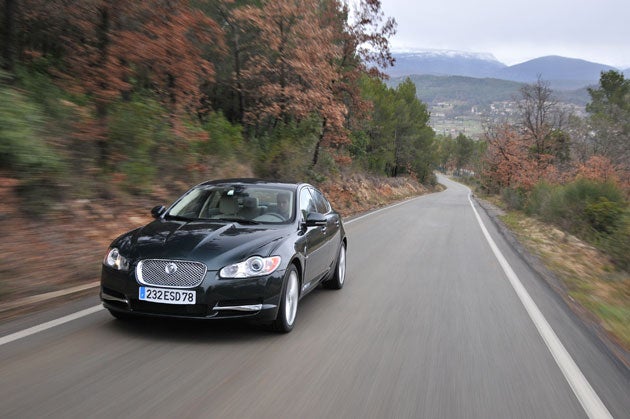Jaguar XF 3.0 Diesel Sport Portfolio
A boosted version of the XF that's sure to silence last year's critics

Price: £44,200
Engine: 3.0 litre V6 turbodiesel
Transmission: six-speed automatic
Top speed: artificially limited to 155 mph
Acceleration: 0-60mph in 5.9 seconds
Fuel consumption: 42.0 mpg (combined cycle)
CO2 emissions: 179 g/km, meets latest Euro 5 standard
Rivals: Audi A6, BMW 5 Series, Mercedes E Class Price: £44,200
Engine: 3.0 litre V6 turbodiesel
Transmission: six-speed automatic
Top speed: artificially limited to 155 mph
Acceleration: 0-60mph in 5.9 seconds
Fuel consumption: 42.0 mpg (combined cycle)
CO2 emissions: 179 g/km, meets latest Euro 5 standard
Rivals: Audi A6, BMW 5 Series, Mercedes E Class
When Jaguar launched the XF last year it became an instant hit. Among the features that were widely praised were the new car’s excellent ride and handling - Jag has long been a master at reconciling the conflicting requirements involved in squaring that particular circle - and the extent to which the XF’s fresh new styling threw off the timidity of the retro design themes of its rather dumpy predecessor, the S-Type. The XF’s interior also won plenty of friends with a number of “surprise and delight” touches such as a rotary gear selector that rose from the centre console when the engine was started; traditional British wood and leather were also present in abundance but in the XF they contrived somehow to appear cool rather than old-fashioned.
Only two real niggles - and in the overall scheme of things, they really were only niggles - detracted from this positive picture. The first was a feeling that the XF’s frontal styling didn’t quite live up to the high standards set by the rest of the car’s design. Here, Jaguar had made a rod for its own back with the C-XF, the concept car that was the precursor to the XF, which had a particularly distinctive and attractive front end with narrow hawk-eyed headlamps.
The second niggle was the feeling that the XF’s most popular engine, the 2.7 litre V6 turbodiesel, while smooth and sweet, and paired with an excellent six-speed automatic gearbox that made the most of its power, could do with a little bit more bite, especially compared with its German rivals.
Well this year, Jaguar has tweaked the XF but its frontal styling remains unchanged - the C-XF’s nose has, however, been carried over more directly to the new, larger XJ model, so at least those who like it and have the cash, can drive a car that has the C-XF look. The XF’s V6 diesel engine, however, has received a big boost that really should silence any doubters. Its capacity has been expanded from 2.7 to three litres and it is now available in two versions - one providing 275 horsepower and 600 Newton metres of torque and another delivering 240 horsepower and 500 Newton metres. Both consume 42mpg on the official combined cycle test and emit 179grames of CO2 per kilometre, data that represent substantial improvements over the 2.7 litre model.
On the road, the new engine should satisfy all but the most demanding drivers. With the more powerful version, the XF gets to 60 mph in just 5.9 seconds - super-car territory just a few years ago, and not far off it even now - and has its top speed artificially limited to 155 mph. My recent testing of the XF took me over some of my favourite UK cross-country routes in North and East Yorkshire, and the Lincolnshire Wolds, and I’m hard pushed to think of any car that could match the Jag as an all-rounder over these fast, open undulating roads. Those that would be as quick wouldn’t match the XF’s extraordinary levels of comfort and ability to provide fatigue-free progress.
What distinguishes this Jaguar from its rivals? Well, you can argue all day about whether the XF is a better car than a BMW Five-Series, a Mercedes E-Class or an Audi A6. Personally I think it can more than hold its own in that company but that isn’t really the point. What the Jag offers over its big-selling German rivals is the fact that it feels just that bit more special. That’s partly because of its rakish design and impressive interior, but also because the XF sells in smaller numbers - and that may be a problem in the long term too.
Jaguar has recently decided to drop its entry-level X-Type, the car that was supposed to take on the BMW 3-Series but never quite hit the mark, and there are still no smaller-engined or estate versions of the XF to take on the big-selling variants of the 5, the E or the A6. Jaguar seems to be shrinking itself into a niche that will see it sell perhaps 60,000 cars per year, priced at £33,000 or more. I’m not sure that will work in the long run against German rivals that are able to reap the benefits of scale by selling over a million cars per year, while at the same time maintaining their ability to extract premium prices from their customers. But the revised XF really is a very good car indeed.
The Rivals:
Audi A6: from £56,220.
BMW 5 Series: from £40,810.
Mercedes E Class: from £30,280.
Subscribe to Independent Premium to bookmark this article
Want to bookmark your favourite articles and stories to read or reference later? Start your Independent Premium subscription today.

Join our commenting forum
Join thought-provoking conversations, follow other Independent readers and see their replies